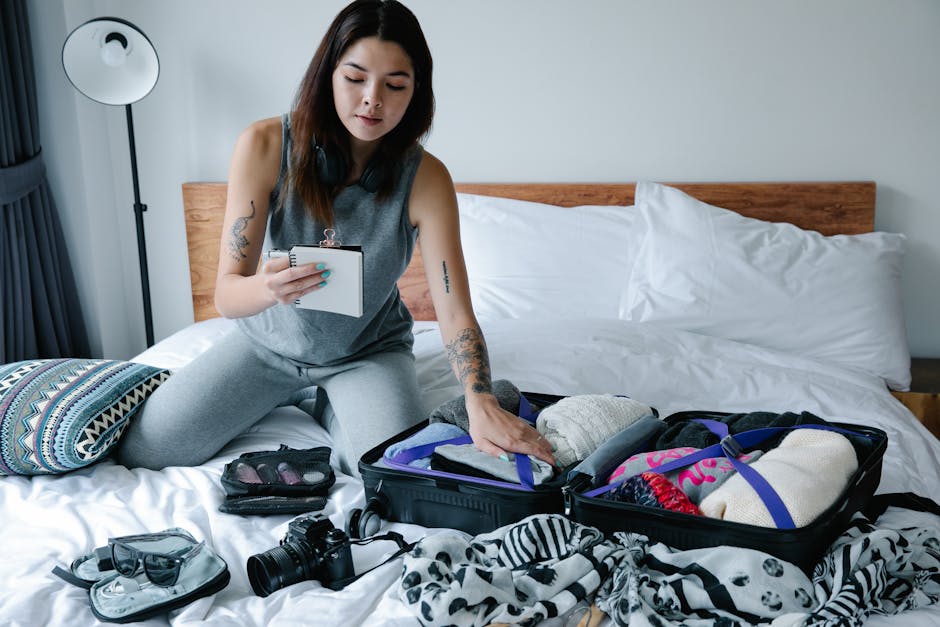Packing Checklists: 7 Amazing Resources
Why a Packing Checklist is Your Best Travel Companion
Packing checklists are organized lists that help travelers remember everything they need for a trip. Here’s what makes them indispensable:
- Reduce stress by eliminating the “Did I forget something?” anxiety.
- Save money by avoiding last-minute purchases of forgotten items.
- Save time by providing a clear roadmap for what to pack.
- Prevent disasters like leaving your wallet or passport at home.
- Stay organized by categorizing items.
The reality is simple: most packing mishaps are preventable. Research shows that travelers who use structured packing lists are far less likely to forget essential items. Whether you’re planning a weekend getaway or a month-long adventure, having a reliable system makes all the difference. The key is starting with a solid master checklist and then customizing it based on your destination, trip length, and activities.
I’m Ramy Saber, founder of GoTravelHunt. Through years of extensive travel, I’ve learned that successful trips start with proper preparation—and packing checklists are the foundation of that preparation. Let me share the resources and strategies that will transform how you pack.
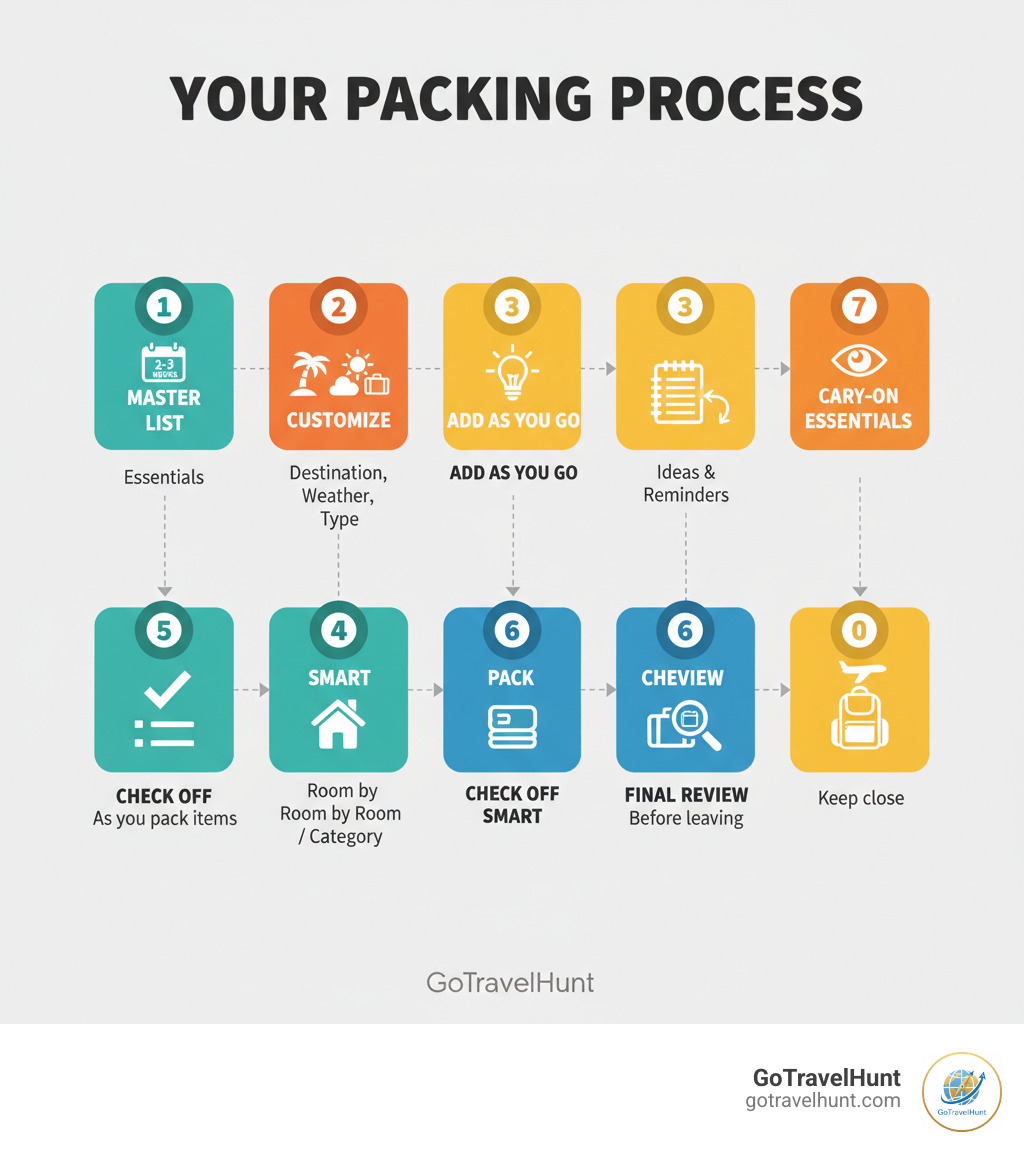
Packing checklists vocab to learn:
- best things to pack for international travel
- best travel packing list
- last minute packing list
The Foundation: Your Master Packing Checklist
Think of your master packing checklist as the blueprint for every trip. It’s the comprehensive starting point that covers all the essentials you can’t leave home without. Once you’ve created it, you can customize it for any adventure, saving you from starting from scratch every time.
Essential Clothing & Apparel
A versatile wardrobe is a travel secret. Focus on pieces that can be mixed, matched, and layered for multiple occasions and unexpected weather.
Start with underwear and socks—plan for one pair per day, plus a few extras. Add one to two comfortable sets of sleepwear. The backbone of your travel wardrobe will be neutral-colored T-shirts and casual shirts that work with everything. For bottoms, include one pair of lightweight pants and one comfortable pair of jeans. A pro tip: wear the heaviest pair on the plane to save luggage space.
Depending on your destination’s climate, pack one to two pairs of shorts or versatile dresses and skirts. Don’t forget a light sweater or cardigan for layering and a versatile jacket—a packable rain jacket like the Marmot Women’s Precip Jacket is excellent if rain is a possibility. And always pack a swimsuit; you never know when an opportunity for a dip will arise.
To keep everything tidy, consider using packing cubes—they are game-changers for suitcase organization. Multi-use wraps and merino wool layers are also worth the investment, as they regulate temperature and resist odors. If you can do laundry on your trip, you can bring fewer items. For a week-long trip, you can manage with a few casual outfits, a couple of dressier options, and activewear, especially if you pack mix-and-match pieces.
Toiletries & Medications
Keep your personal care items organized and compliant with travel regulations to avoid surrendering your favorite moisturizer at security.
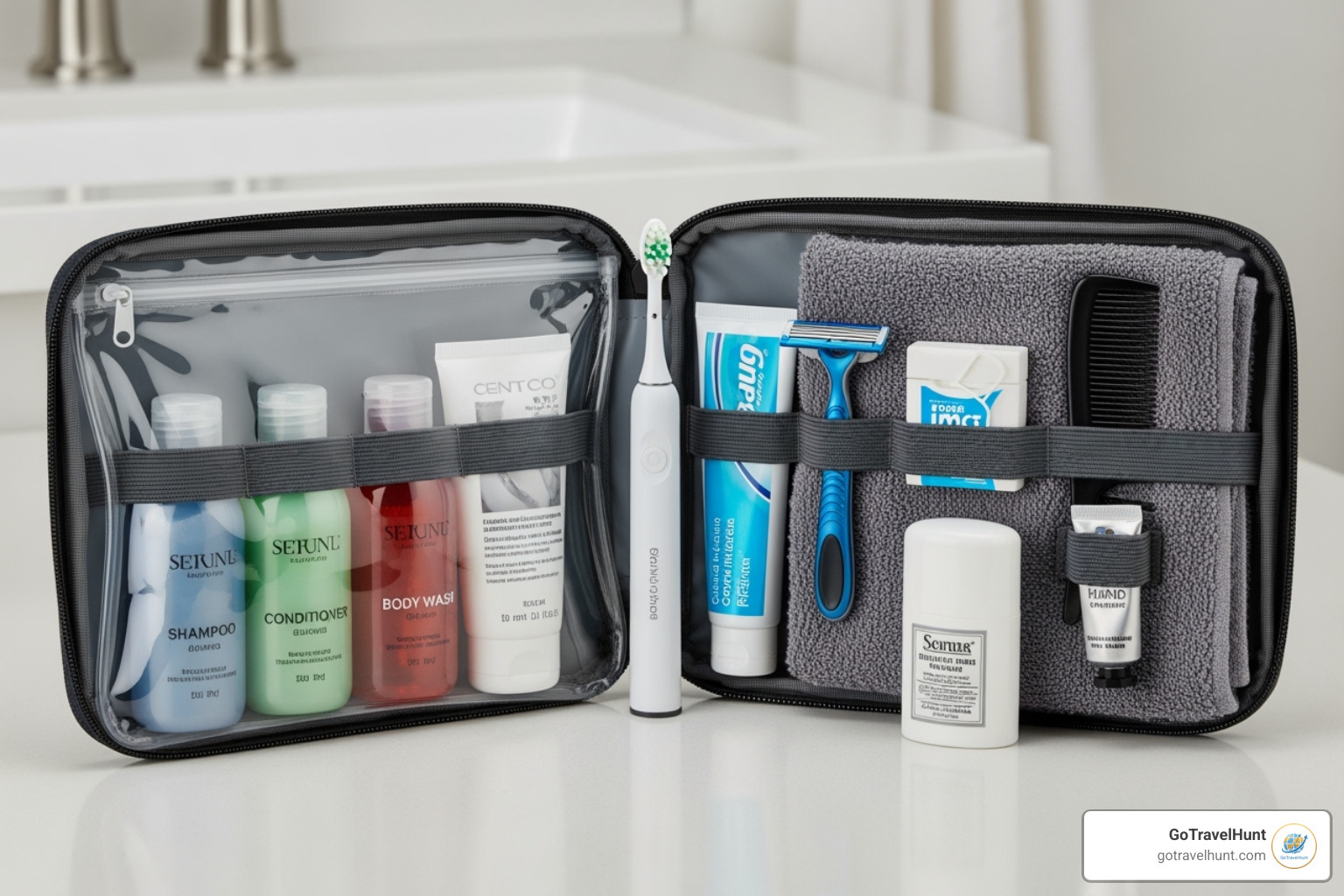
Start with the basics: toothbrush, toothpaste, dental floss, soap, deodorant, shampoo, and conditioner. For skincare, pack a facial cleanser, face lotion, and a good broad-spectrum sunscreen—this last one is non-negotiable. Include a hair brush and any necessary styling tools.
For health and wellness, keep all prescription medication in its original container; a doctor’s note is wise for international travel. Build a basic first-aid kit with ointment, bandages, pain relievers, and hand sanitizer. If you wear contacts, pack enough lenses and solution for your trip, plus a backup pair of glasses.
Remember the TSA 3-1-1 rule for carry-on liquids: containers must be 3.4 ounces (100 milliliters) or less, all fitting in one quart-sized clear bag. For specific questions, check the official TSA guidelines for traveling with medication. We recommend keeping all essential medications and hand sanitizer in your carry-on for easy access.
Essential Documents, Money, and Electronics
These items are non-negotiables and should always be in your carry-on luggage, never in checked bags.

For identification, you’ll need your passport, visa, or ID and your driver’s license. For financials, bring debit and credit cards, preferably ones without foreign transaction fees, and some local currency. It’s also smart to have a small emergency stash of cash tucked away.
Your travel information should include digital and physical copies of your itinerary, flight and accommodation confirmations, and a list of emergency contacts. For electronics, pack your phone and all necessary chargers. A plug adapter is essential for international travel, so be sure to research the requirements for your specific destination. A smart move is to scan copies of your passport and other vital documents and save them in secure cloud storage.
The “Never Forget Again” List
This part of your packing checklists is for those sneaky items that are easy to forget.
- Phone charger and power bank: A dead phone at your destination is a nightmare. A portable charger is one of the best travel investments.
- Prescription medication: Keep it in your carry-on, always.
- Sunglasses: Essential for protecting your eyes.
- House keys: You’ll want these when you get home!
- Copy of your passport: A physical or digital copy can be a lifesaver if the original is lost.
- Empty water bottle: Stay hydrated and save money by refilling it after security.
- Headphones: Quality headphones like the Bose QuietComfort Earbuds II can transform a long flight.
Customizing Your Packing Checklists for Any Adventure
The real power of packing checklists comes from tailoring them to your specific adventure. What you need for a business conference is vastly different from what you’d bring on a backpacking trip. Customizing your list helps you avoid both overpacking and under-packing.
For Different Trip Types and Durations
First, ask yourself: what kind of trip is this? The answer shapes what goes into your suitcase.
- Business travel requires professional, wrinkle-resistant attire, comfortable shoes, and essential tech. Always keep a complete meeting outfit in your carry-on in case of lost luggage.
- Leisure travel strategies shift based on your company. For romantic weekend getaways for couples, pack date-night outfits. For adventure getaways, you’ll need gear for activities like hiking. For solo travel destinations, packing light is key for mobility and safety.
Trip duration is also crucial. For short trips (3-5 days), you can get by with a few versatile outfits. For longer trips (a week or more), don’t just double everything. Instead, plan to do laundry. Packing a small travel laundry kit allows you to refresh clothes and pack significantly lighter. Before finalizing your list, consider your planned activities and laundry access to create your perfect packing blueprint.
For Specific Destinations and Weather
Never skip checking the weather forecast. Dig into temperature, humidity, and precipitation chances for your destination.
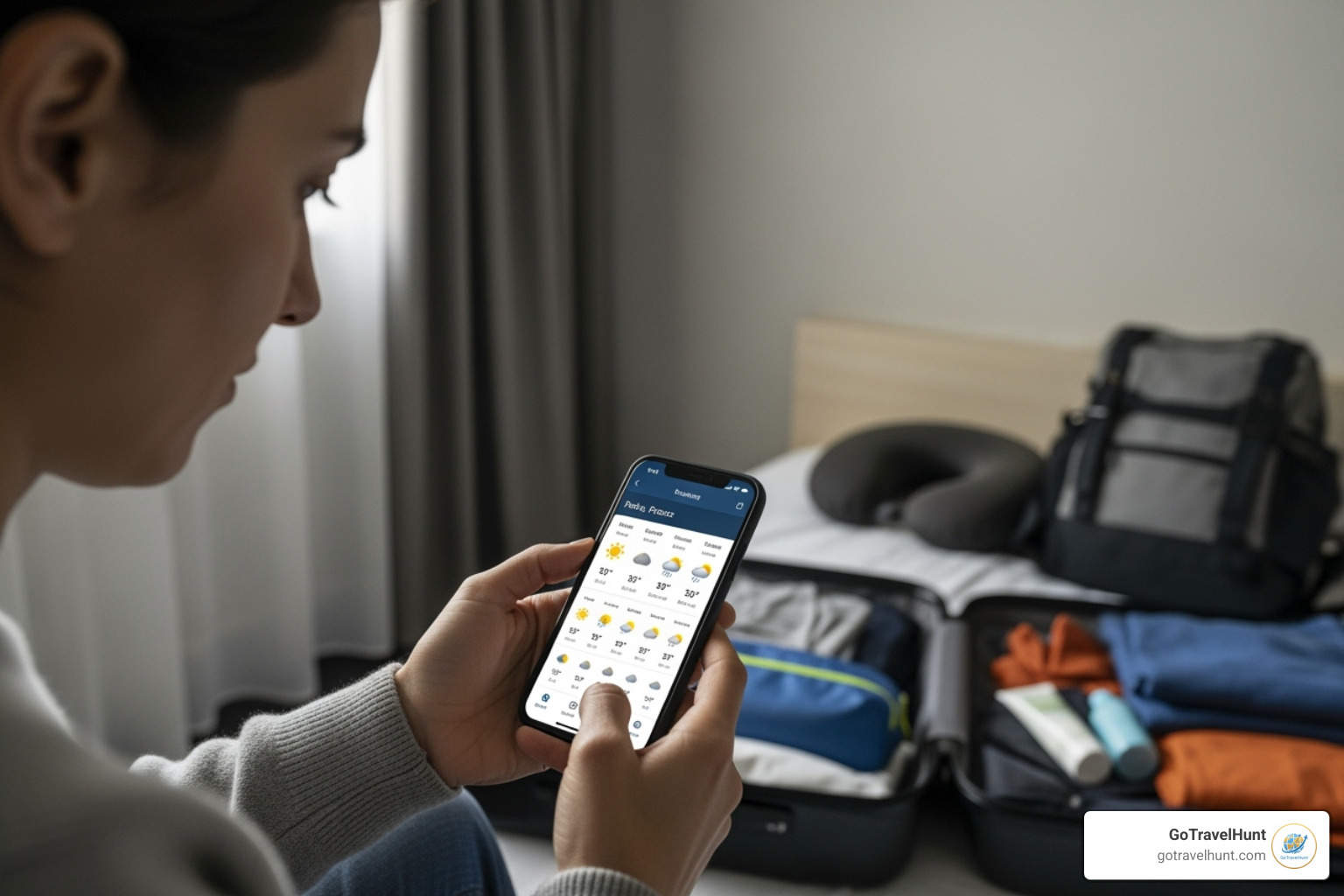
Researching your destination’s climate and typical weather patterns is key. The golden rule for adapting to any climate is layering clothes. This lets you adjust to changing temperatures by adding or removing items like a base layer, a fleece, and an outer shell.
If there’s a chance of rain, pack a lightweight, packable rain jacket. Depending on your destination, you might also want rain pants or a compact umbrella. For sunny destinations, sun protection is non-negotiable. Your packing checklists must include high-SPF sunscreen, a wide-brimmed hat, and quality sunglasses.
Different destinations also have unique needs. A city break packing list should prioritize comfortable walking shoes and versatile outfits. For international travel, practical details matter. Always check power plug adapter and currency exchange requirements before you go. This research turns a generic template into a custom guide for your journey.
Pro-Level Strategies: Packing Hacks and Luggage Choices
Packing isn’t just about what you bring—it’s about how you bring it. The right strategies can transform your suitcase from a jumbled mess into a well-organized travel companion, and choosing the right luggage can make or break your trip.
Space-Saving Hacks to Pack Like a Pro
With a few clever techniques, you can pack more efficiently than you ever thought possible.
- Roll your clothes. Tightly rolling casual items like t-shirts and pants generally saves more space and reduces wrinkles compared to folding.
- Use packing cubes. These organizers compartmentalize your belongings and compress clothing, creating more room in your suitcase.
- Fill dead space. Stuff smaller items like socks and chargers inside your shoes. Tuck belts around the inside perimeter of your bag.
- Choose multi-purpose items. A multi-use wrap can be a scarf, blanket, or beach cover-up. Items made from merino wool are great because they regulate temperature and resist odors.
- Stick to a neutral color palette. When your clothes are in shades of black, navy, gray, and white, everything mixes and matches effortlessly, allowing you to create more outfits with fewer items.
- Wear your bulkiest items. Wear your heavy coat, hiking boots, or thick sweater on the plane to free up precious luggage space.
These strategies will turn what used to be a stressful ordeal into a streamlined process.
Carry-On Only vs. Checked Luggage: A Key Decision for Your Packing Checklists
One of the most important choices you’ll make is whether to travel carry-on only or check a bag. This decision impacts every other packing choice.
We’re big advocates for carry-on only travel. The freedom of walking off a plane and heading straight to your destination is best. You avoid baggage claim, move through airports faster, and eliminate the risk of lost luggage and checked bag fees.
However, checked luggage has its place. You may need more space for long trips with varied climates, specialized equipment, or if you’re traveling with children. If you do check a bag, consider using luggage trackers like AirTags or Tile Mate to keep tabs on your bag’s location.
| Feature | Carry-On Only | Checked Luggage |
|---|---|---|
| Mobility | High (easy to steer) | Low (cumbersome) |
| Cost | Often free | Often incurs extra fees |
| Security | Lower risk of loss/theft | Higher risk of loss or damage |
| Speed | Faster through airport | Slower (wait at baggage claim) |
| Packing Limits | Strict size/weight/liquid rules | More generous limits |
Regardless of your choice, these items should always stay in your carry-on:
- Valuables (jewelry, cameras)
- All prescription medications
- Important documents (passport, ID, wallet)
- A complete change of clothes
- Electronics and their chargers
Modernize Your Method: Digital Tools and Printable Resources
Technology has revolutionized travel planning, and our packing checklists are no exception. Digital tools make packing more efficient, organized, and stress-free. Whether you prefer a tech-savvy approach or the classic pen-and-paper method, there’s a solution for you.
Using Apps and Technology to Streamline Packing
The beauty of digital packing checklists is that they’re always accessible and easy to customize. Once you create a master list, you can duplicate and modify it in seconds for your next adventure.
Packing list apps are a great resource, often pre-loaded with suggestions based on your destination and trip type. For a more flexible approach, digital note-taking apps like Evernote or Google Keep work beautifully. You can create lists, add comments, and sync them across your devices.
Setting reminders transforms your checklist into an active planning tool. Set alerts to start your list 1-2 weeks before departure, check the weather three days out, and do a final review the night before you leave. These nudges help you stay on track.
Luggage trackers like AirTags or Tile Mate have become essential travel companions. Slip one into your checked bag, and you’ll always know its location, providing peace of mind.
Finally, using an App to Track Travel Itinerary helps ensure your packed items align with your scheduled activities. If a fancy dinner is planned, you’ll remember to pack a suitable outfit.
Your Free Printable Packing Checklist
While digital tools are great, there’s a deep satisfaction in physically checking off items on a printed list. A tangible checklist provides a sense of control and accomplishment that a screen can’t always replicate.
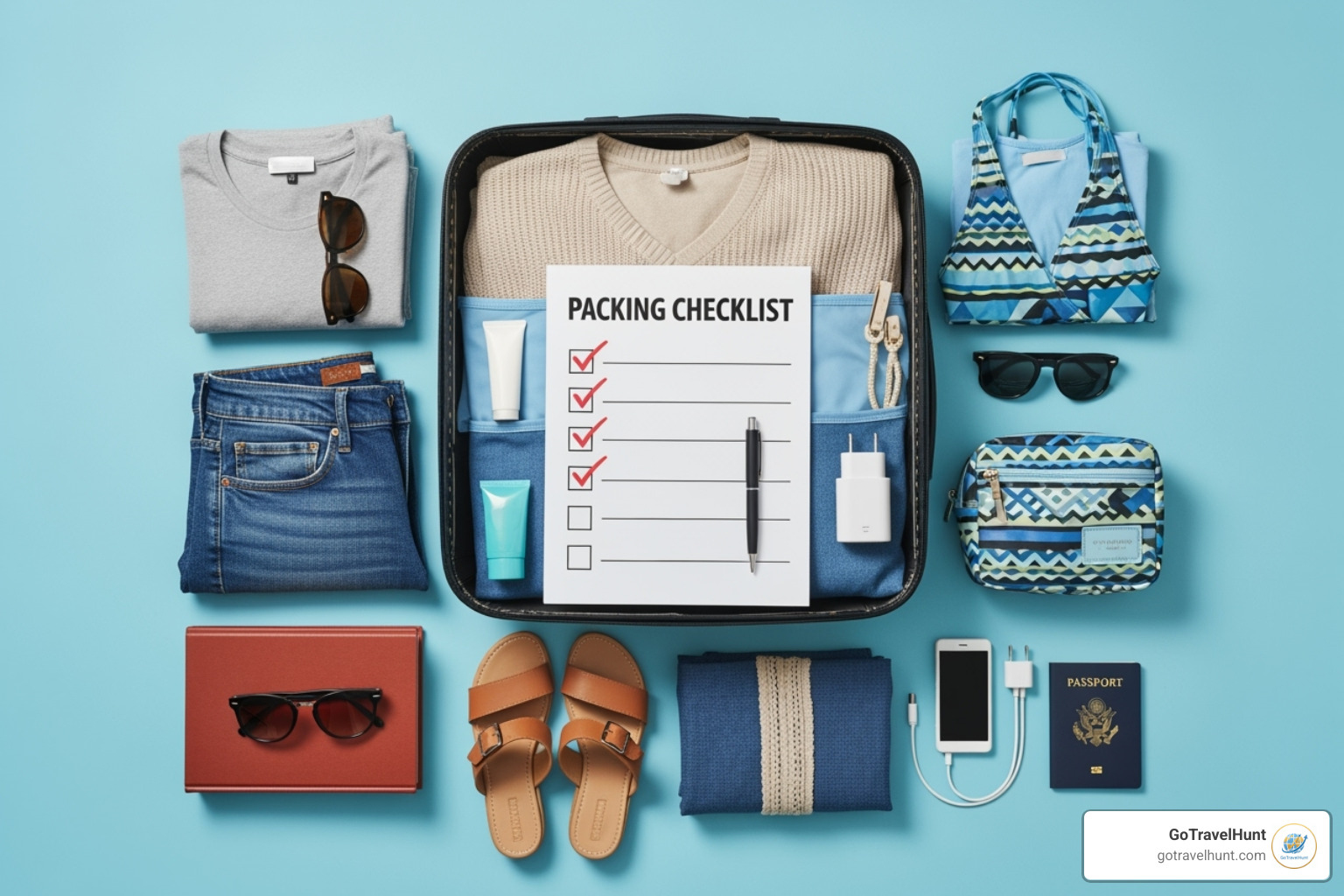
A high-quality downloadable printable checklist serves as the perfect starting point. Print it out, spread it on your bed while you pack, and enjoy the process. The beauty of a template is its flexibility. Grab a pen to customize it with your own notes, cross out items you don’t need, and add trip-specific gear.
For those who want the best of both worlds, interactive online checklists offer a middle ground. These digital versions let you click to select items and then print the final customized version. You can find a comprehensive travel packing checklist on our site to adapt for any journey.
Whether you’re team digital or team paper, the most important thing is having a system that works for you. Your packing checklists should make travel easier, not more complex.
Frequently Asked Questions about Packing Checklists
Travel planning brings up plenty of questions. Here are the most common ones we get about packing checklists, answered with insights from our years of travel experience.
How far in advance should I start my packing list?
The sweet spot is 1-2 weeks before departure. This gives you a stress-free buffer to take inventory, order any missing items, and adjust your list based on weather forecasts. Starting early is the best way to avoid forgetting essentials and making expensive last-minute purchases at the airport.
What’s the best way to pack shoes?
Shoes are bulky, but they can be packed efficiently. Place shoes heel-to-toe along the sides of your suitcase to create a stable base. To maximize space, stuff them with smaller items like socks, underwear, or chargers. This also helps your shoes maintain their shape. Always use shoe bags or disposable shower caps to prevent dirt from transferring to your clean clothes.
How many outfits should I pack for a 7-day trip?
For a week-long trip, a good guideline is 3-4 casual outfits, 2-3 dressier outfits, and 1-2 activewear outfits. The key is to pack versatile, mix-and-match pieces in neutral colors to create multiple looks. If you’ll have access to laundry facilities, you can pack significantly less—enough for just a few days—and wash clothes mid-trip. This is the secret to lighter, more flexible travel.
Conclusion: Pack Smarter, Travel Better
Every great adventure begins long before you reach your destination—it starts the moment you begin to pack. A thoughtfully crafted packing checklist is your secret weapon against travel stress and your ticket to a smoother, more enjoyable journey.
The goal isn’t perfection—it’s preparation. It’s about giving yourself the peace of mind that comes from knowing you’ve packed intentionally. It’s about arriving at your destination ready to immerse yourself in new experiences, not scrambling to replace forgotten items.
At GoTravelHunt, we’re passionate about making your travel journey as enjoyable as the trip itself. We believe successful adventures are built on solid planning that is stress-free, affordable, and perfectly suited to your unique wanderlust.
So go ahead: start that packing checklist, customize it for your next adventure, and step confidently into your travels. The world is waiting. Start planning your next unforgettable trip with our comprehensive Travel Planning Guides, and let’s make your travel dreams a reality together.

